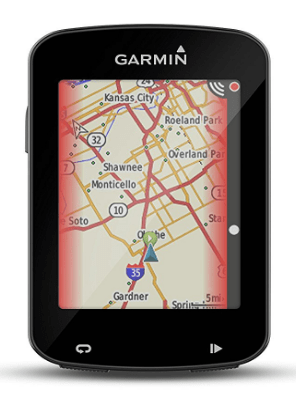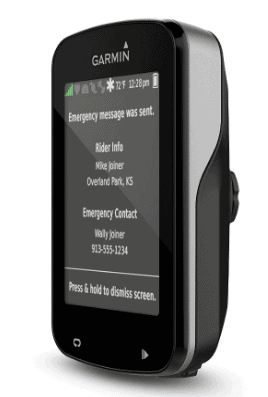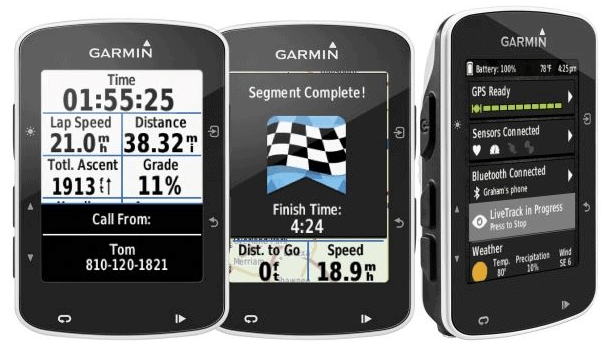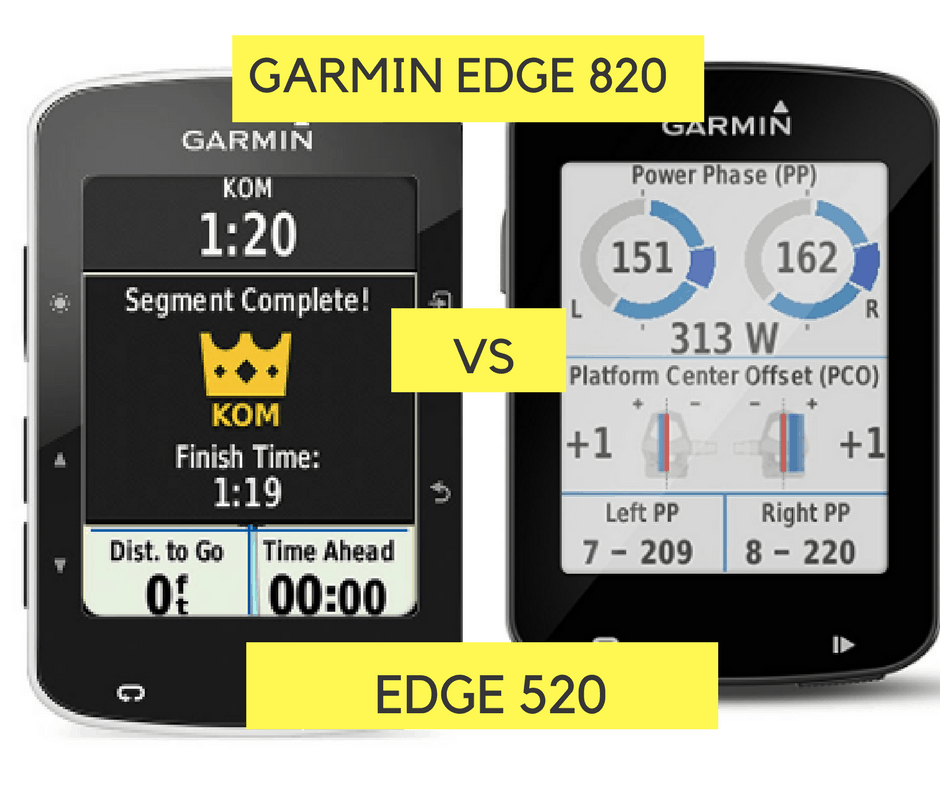- 14 of the Best Trail-Ready Mountain Bike Shoes - October 5, 2021
- Best Cycling Gloves: Protect Your Mitts! - January 2, 2020
- 13 Best Shred-Worthy Mountain Bike Gloves - September 29, 2019
Garmin has dominated the bike computer market for years, so if you’re looking to invest in a new computer, likelihood is you’ll be looking at their range. But which of their (many) products is the right one for you?
Today we’re pitting two of Garmin’s most popular and advanced models against each other: in the red corner, we have the Edge 520, and, challenging in the blue corner, is the Edge 820.
These are not basic GPS units – they’re designed to be advanced training and performance tools. If you’re just starting out cycling and looking for a basic unit to track your rides, then I’d recommend the cheaper, more basic Edge 25. But if you’re a Strava addict or want to monitor your power numbers, then you are in the right place.
So, without further ado, let’s get down to business.
Garmin Edge 520
Weight: 2.1 oz
Size: 1.9” x 2.9” x 0.8”
20-word summary: A fully-featured training tool in a tiny package that’s great for competitive cyclists and those who love training.
Garmin Edge 820
This lightweight, compact and high-resolution touchscreen display GPS cycling computer offers advanced performance monitoring and has up to 15 hours of battery life for you to have more adventurous rides!
Weight: 2.4 oz
Size: 1.9” x 2.9” x 0.8”
20-word summary: A high-spec training tool that’ll tell you which way to go, help you stalk your mates and call an ambulance if you crash*.
(*Ok, so it’ll actually call an emergency contact who can then call an ambulance – Garmin are very keen to point out it won’t contact emergency services directly on your behalf.)
What the Edge 520 and Edge 820 have in common
At first glance, a lot. They’re exactly the same size, pretty much the same color (black) and both weigh as much as a large egg (i.e. not a lot). The screen size is a little bigger on the 820, but not so much that you’d really notice a difference.
Both devices are designed for data geeks with advanced performance and power analysis tools including VO2 max, FTP, recovery and cycling dynamics (heart rate strap required for some features).
Yes, the 820 has a few additional features, such as the stress score, but unless you’re an elite athlete, the 520 has pretty much everything you need on this score.
The 520 and 820 are both compatible with ANT+ trainers, so you can check how hard you’re working and set up a workout where your Garmin device controls the trainer to ensure you hit your target.

If you’re after real competition, they’re also compatible with Strava Live Segments. You’ll get an alert when you’re approaching a segment and at the end, it’ll tell you exactly how fast (or slow) you are compared to your friends, the Strava league table, and your younger, svelte self.
Mountain bikers and city dwellers will be glad to know that both devices are compatible with GPR and GLONASS for fast satellite acquisition, and if your family and friends like to keep track of you racing, you (or they) will be a fan of the LiveTrack GPS tracking feature.
You can also pair either device with your smartphone to receive messages from your loved ones when racing.
In summary, if your primary purpose in buying a cycling computer is to help you train and compete against others (or yourself), both devices will do a great job.
So What’s the Difference?
Now we get to the interesting bit. There are four significant differences between the Edge 520 and the Edge 820:
- Mapping
- GroupTrack
- Incident detection
- Touchscreen
Let’s delve down into the details…
Mapping
If you’re trying to decide between the 520 and the 820, your decision is likely to come down to mapping. On the 520 you get a (very) basic map that shows you what direction you’re going in, but if you go off-route, it’s up to you to get back on track.
The 820 has a preloaded Garmin Cycle Map with turn-by-turn navigation that’ll tell you exactly where to go and re-route you if you go off-track (similar to a car GPS).
The map covers both road and off-road paths and you can upload GPX route files. There’s also a round-trip routing feature that allows the 820 to select a route for you between two places.
Although the Edge 520 doesn’t come with a detailed map, you can get around this by downloading free, detailed Openstreet maps – there’s a tutorial on how to do this here. It’s a bit more effort and not as sophisticated as the 820 but many people have used it just fine. (Unless you upload a route, you will still need to do the navigating.)
GroupTrack
If you’ve ever wanted to stalk your mates, now you can. (In a completely legal, non-scary way of course.) You can pair your 820 to your friends’ 820s to keep track of each other, making it easy to meet up at a particular point. Of course, this assumes your friends have also invested in the Edge 820 (orEdge 1000).
This is an upgrade to the LiveTrack feature on the 520, and if your friends have the Edge 520 you’ll be able to see them on your map, but they won’t be able to see you. (All the better for stalking…)
Incident Detection

The 820 has a new incident detection feature. When it picks up a ‘crash’, it’ll send a text message to your designated emergency contact to tell them you’ve had an incident.
If you do a lot of solo rides then this may come in handy, particularly if you’re off-road. Bear in mind that the message is sent via your cell phone, so if you’re out of reception your message won’t send.
Also, if you’re a mountain biker who regularly does a lot of harsh braking or you stop to take photos, then you could end up with a few false alarms.
You get a 30-second countdown to cancel the alert, but if you’re tangled up in your bike that’s not very long to scrape yourself off the trail and press the big red button.
Still, one or two false alarms are arguably a small price to pay for a feature that could save your life.
Touchscreen
The 820 has a touchscreen. The 520 doesn’t. This really comes down to personal preference – either you like pressing buttons or you like using a screen. It’s worth noting that the touchscreen on the 820 works by pressure-sensing, so you can use it with gloves on.
Some people have reported issues with the touchscreen responding to rain and sweat, but Garmin claims they’ve fixed this sensitivity issue in a recent upgrade.
Other Considerations
There are a couple of other things the 820 can do which the 520 can’t. If you’ve got a heart rate strap, there’s a Stress Score feature, which will tell you if your body is ready for another tough workout or if you should just stay at home and meditate in a warm bath instead.
The 820 is also Wi-Fi compatible, so you can upload your ride using Wi-Fi rather than via your phone. Handy, but probably not a deal-breaker.
Although both devices have a similar battery life (up to fifteen hours), the 820 has a battery-saver setting which can increase the battery life by up to 50%. This may be useful if you’re doing a particularly epic ride, BUT it’s dependent on the screen and other features being disabled, so there is a trade-off.
The Bug Factor

If you read the user reviews on any large site for both the 520 and the 820, you’ll find a mix of lucky buyers who’ve had no problems and unfortunates who are ready to chuck their expensive new device at a brick wall.
The 820 perhaps comes out slightly worse in this regard based on recent reviews, but that may just be because it’s a newer model so Garmin hasn’t got all the problems sorted out yet. If this kind of thing really bugs you, then the only guaranteed solution is to switch to a good old-fashioned paper map and stopwatch. Hence, no technology is perfect.
Which Garmin Edge Should You Buy?
Well, it really depends on what you want it for. If you’re after a tool for training and tracking rides, and you regularly ride the same, familiar routes, then the Edge 520 is more than adequate and it’s a nice upgrade from the Edge 500.
If you travel a lot or like exploring new routes (or are directionally-challenged), then it’s probably worth shelling out the extra hundred bucks for the Edge 820.
Both computers are equally at home on and off the road and while the crash-notification feature may be useful if you cycle alone, it’s probably not going to be the deciding factor in your choice.
What about triathletes? Well, theoretically you could run with either the Edge 520 or 820 and you could probably DIY a quick release strap, but it’s not an ideal solution? For a start, it won’t display the running information you really want (e.g. min/km) and you’ll have to manually update your Strava activity logging which is a hassle.
If you’re looking for a device you can use for both running and cycling then you’re going to be better off with a sports watch like the Garmin 735XT.
If only the best will do, and budget isn’t at the forefront of your mind, you may also want to check out our comparison of the Edge 820 and the Edge 1000.


